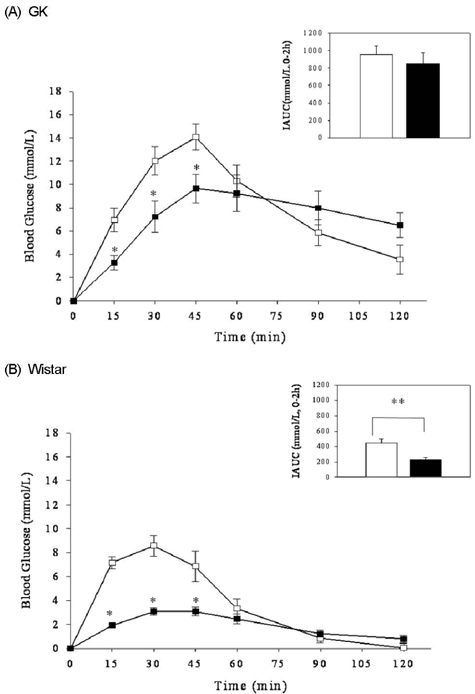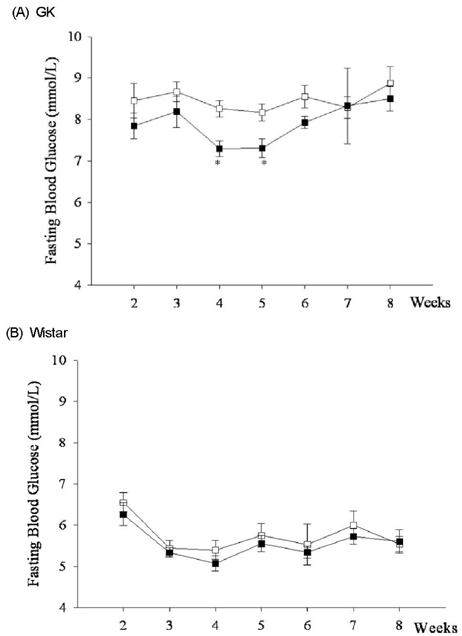Nutr Res Pract.
2009 Dec;3(4):272-278.
Postprandial hypoglycemic effect of mulberry leaf in Goto-Kakizaki rats and counterpart control Wistar rats
- Affiliations
-
- 1Department of Nutritional Science and Food Management, Ewha Woman's University, 11-1 Daehyeon-dong, Seodeamun-gu, Seoul 120-750, Korea. orank@ewha.ac.kr
Abstract
- Postprandial hypoglycemic effect of mulberry leaf (Morus alba L.) was compared in two animal models: Goto-Kakizaki (GK) rats, a spontaneous non-obese animal model for type II diabetes, and their counterpart control Wistar rats. First, the effect of a single oral administration of mulberry leaf aqueous extract (MLE) on postprandial glucose responses was determined using maltose or glucose as substrate. With maltose-loading, MLE reduced peak responses of blood glucose significantly in both GK and Wistar rats (P < 0.05), supporting the inhibition of alpha-glucosidase by MLE in the small intestine. With glucose-loading, MLE also significantly reduced blood glucose concentrations, measured at 30 min, in both animal models (P < 0.01), proposing the inhibition of glucose transport by MLE. Next, dried mulberry leaf powder (MLP) was administered for 8 weeks by inclusion in the diet. By MLP administration, fasting blood glucose was significantly reduced at weeks 4 and 5 (P < 0.05), but then returned to values that were similar to those of the control at the end of experimental period in GK rats. Insulin, HOMA-IR, C-reactive protein, and triglycerides tended to be decreased by MLP treatment in GK rats. All other biochemical parameters were not changed by MLP administration in GK rats. Collectively, these findings support that MLE has significant postprandial hypoglycemic effect in both non-obese diabetic and healthy animals, which may be beneficial as food supplement to manage postprandial blood glucose. Inhibitions of glucose transport as well as alpha-glucosidase in the small intestine were suggested as possible mechanisms related with the postprandial hypoglycemic effect of MLE.
MeSH Terms
-
Administration, Oral
alpha-Glucosidases
Animals
Blood Glucose
C-Reactive Protein
Diet
Dietary Supplements
Fasting
Glucose
Hypoglycemic Agents
Insulin
Intestine, Small
Maltose
Models, Animal
Morus
Rats
Rats, Wistar
Triglycerides
Blood Glucose
C-Reactive Protein
Glucose
Hypoglycemic Agents
Insulin
Maltose
Triglycerides
alpha-Glucosidases
Figure
Reference
-
1. Andallu B, Varadacharyulu NC. Antioxidant role of mulberry (Morus indica L. cv. Anantha) leaves in streptozotocin-diabetic rats. Clin Chim Acta. 2003. 338:3–10.
Article2. Andallu B, Varadacharyulu NC. Gluconeogenic substrates and hepatic gluconeogenic enzymes in streptozotocin-diabetic rats: effect of mulberry (Morus indica L.) leaves. J Med Food. 2007. 10:41–48.
Article3. Asano N, Yamashita T, Yasuda K, Ikeda K, Kameda Y, Kato A, Nash RJ, Lee HS, Ryu KS. Polyhydroxy alkaloids islated from mulberry trees (Morus alba L.) and silkworms (Bombyx mori L.). J Agric Food Chem. 2001. 49:4208–4213.
Article4. Avignon A, Radauceanu A, Monnier L. Nonfasting plasma glucose is better marker of diabetic control than fasting plasma glucose in type 2 diabetes. Diabetes Care. 1997. 20:1822–1826.
Article5. Chan JC, Malik V, Jia W, Kadowaki T, Yajnik CS, Yoon KH, Hu FB. Diabetes in Asia: epidemiology, risk factors, and pathophysiology. J Am Med Assoc. 2009. 301:2129–2140.6. Goda T, Suruga K, Komori A, Kuranuki S, Mochizuki K, Makita Y, Kumazawa T. Effects of miglitol, an α-glucosidase inhibitor, on glycaemic status and histopathological changes in islets in non-obese, non-insulin-dependent diabetic Goto-Kakizaki rats. Br J Nutr. 2007. 98:702–710.
Article7. Goto Y, Efendic S. Abnormal insulin secretion and glucose metabolism in pancreatic islets from the spontaneously diabetic GK rat. Diabetologia. 1993. 36:3–8.
Article8. Igarashi K, Honma K, Yoshinari O, Nanjo F, Hara Y. Effect of dietary catechins on glucose tolerance, blood pressure and oxidation statues in Goto-Kakizaki rats. J Nutr Sci Vitaminol. 2007. 53:496–500.
Article9. Janssen U, Phillips AO, Floege J. Rodent models of nephropathy associated with type 2 diabetes. J Nephrol. 1999. 12:159–172.10. Kim J, Kim S, Lee HS, Kim I, Ahn MY, Ahn MY. Determination of 1-deoxynojirimycin in Morus alba L. leaves by derivatization with 9-fluorenylmethyl chloroformate followed by reversed-phase high-performance liquid chromatography. J Chromatogr A. 2003. 1002:93–99.
Article11. Kimura T, Nakagawa K, Kubota H, Kojima Y, Goto Y, Yamagishi K, Oita S, Oikawa S, Miyazawa T. Food-grade mulberry powder enriched with 1-deoxynojirimycin suppresses the elevation of postprandial blood glucose in humans. J Agric Food Chem. 2007. 55:5869–5874.
Article12. Kimura T, Nakagawa K, Saito Y, Yamagishi K, Suzuki M, Yamaki K, Shinmoto H, Miyazawa T. Determination of 1-deoxynojirimycin in Mulberry leaves using hydrophilic interaction chromatography with evaporative light scattering detection. J Agric Food Chem. 2004. 52:1415–1418.
Article13. Kwon O, Eck P, Chen S, Corpe CP, Lee JH, Kruhlak M, Levine M. Inhibition of the intestinal glucose transporter GLUT2 by flavonoids. FASEB J. 2007. 21:366–377.
Article14. Lee SK, Hwang JY, Song JH, Jo JR, Kim MJ, Kim ME, Kim JI. Inhibitory activity of Euonymus alatus alpha-glucosidase in vitro and in vivo. Nutr Res Pract. 2007. 1:184–188.15. Miyahara C, Miyazawa M, Satoh S, Sakai A, Mizusaki S. Inhibitory effects of mulberry leaf extract on postprandial hyperglycemia in normal rats. J Nutr Sci Vitaminol. 2004. 50:161–164.
Article16. Nakagawa K, Kubota H, Kimura T, Yagashita S, Tsuzuki T, Oikawa S, Miyazawa T. Occurrence of orally administered mulberry1-Deoxynojirimycin in rat plasma. J Agric Food Chem. 2007. 55:8928–8933.
Article17. Nutrition Research Council. Guide for the care and use of laboratory animals. 1997. 4th Edition. USA: National Academy Press Washington DC.18. Oku T, Yamada M, Nakamura M, Sadamori N, Nakamura S. Inhibitory effects of extractives from leaves of Morus alba on human and rat small intestinal disaccharidase activity. Br J Nutr. 2006. 95:933–938.
Article19. Prosky L, Asp NG, Furda I, Devries JW, Schweizer TF, Harland BF. Determination of total dietary fiber in food and food products: Collaborative study. J Assoc Off Anal Chem. 1984. 67:1044–1052.
Article20. Prosky L, Asp NG, Schweizer TF, Devries JW, Furda I. Determination of insoluble and soluble dietary fiber in foods and food products: collaborative study. J AOAC Int. 1992. 75:360–367.
Article21. Rother KI. Diabetes treatment-bridging the divide. N Engl J Med. 2007. 356:1499–1501.22. Voss AA, Diez-Sampedro A, Hirayama BA, Loo DDF, Wright EM. Imino sugars are potent agonists of the human glucose sensor SGLT3. Mol Pharmacol. 2007. 71:628–634.
Article23. Wheeler ML, Pi-Sunyer FX. Carbohydrate issues: type and amount. J Am Diet Assoc. 2008. 108:S34–S39.
Article24. Wild S, Roglic G, Green A, Sicree R, King H. Global prevalence of diabetes: estimates for the year 2000 and projections for 2030. Diabetes Care. 2004. 27:1047–1053.
Article25. Wong JMW, Jenkins DJA. Carbohydrate digestibility and metabolic effects. J Nutr. 2007. 137:2539S–2546S.
Article26. Yatsunami K, Ichida M, Onodera S. The relationship between 1-deoxynojirimycin content and alpha-glucosidase inhibitory activity in leaves of 276 mulberry cultivars (Morus spp.) in Kyoto, Japan. J Nat Med. 2008. 62:63–66.
Article27. Zhou YP, Ostenson CG, Ling ZC. Deficiency of pyruvate dehydrogenase activity in pancreatic islets of diabetic GK rats. Endocrinology. 1995. 136:3546–3551.
Article
- Full Text Links
- Actions
-
Cited
- CITED
-
- Close
- Share
- Similar articles
-
- Hypoglycemic effect of Chlorella vulgaris intake in type 2 diabetic Goto-Kakizaki and normal Wistar rats
- Postprandial hypoglycemic effects of mulberry twig and root bark in vivo and in vitro
- Effects of Mulberry Leaf Powder Supplementation on Lead Status and Minerals content in Pb-administered Rats
- Effect of the combination of metformin and fenofibrate on glucose homeostasis in diabetic Goto-Kakizaki rats
- Effects of Mulberry Juice and Cake powders on Blood Glucose and Lipid Lowering and Erythrocytic Antioxidative Enzyme Activities in Streptozotocin -Induced Diabetic Rats





